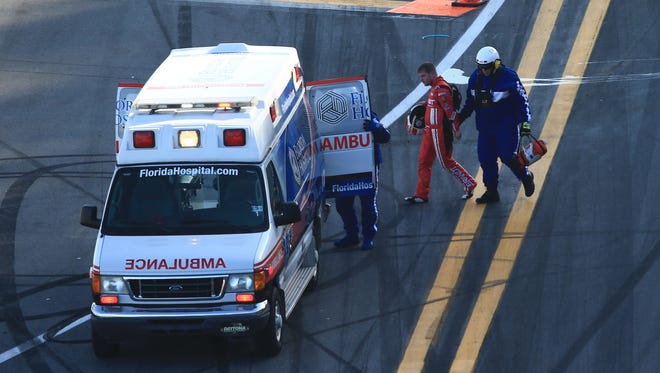NASCAR makes safety push with traveling medical team, enhanced testing

The two white trucks perched alongside the track as Daytona Speedweeks kicked off this weekend marked one of the most visible changes to NASCAR’s safety protocol since Dale Earnhardt Sr.’s death on the same track 16 years ago.
The trucks — each outfitted with a doctor and paramedic — will be at each NASCAR Monster Energy Cup Series weekend this season as part of a partnership with American Medical Response (AMR), announced earlier this month. The move brings NASCAR more in line with what the Verizon IndyCar Series and other major racing organizations have had for decades: dedicated traveling safety teams.
“You ask why now?” Jim Cassidy, vice president of NASCAR racing operations, told USA TODAY Sports. “We are always looking for improvements in the area of safety and this has been on our radar for a couple years. The drivers council meetings tend to focus a large amount on safety and competition. Through those conversations, we came up with a path that makes sense.”
This is the second full season for the 10-member NASCAR drivers council and founding member Denny Hamlin told reporters the addition of the safety team is a sign that series officials are “listening and they’re making changes on our behalf.”
“We’ve always advocated you have to be a little more consistent with doctors because you just never know,” Hamlin said. “Each race track has its own set of doctors, all well qualified, but maybe they don’t know our personalities as much as the traveling doctors do that go every week. I think it’s important that we have that steady staff that understands the patients and has a good relationship with them.”
RELATED COVERAGE:
NASCAR adds traveling medical team for all Cup races
The roots of modern U.S. traveling safety teams trace to the early days of CART, the open-wheel racing series that morphed into Champ Car before it merged with IndyCar in 2008.
Terry Trammell, who has been a trackside physician for more than 30 years, was one of the CART safety members credited with saving the life of Alex Zanardi after a gruesome 2001 crash that resulted in amputation of both his legs.
“I think the immediacy of care and the knowledge provided makes a difference,” Trammell told USA TODAY Sports.
AMR will staff the safety team with a small pool of about six physicians along with an unspecified number of paramedics that will rotate throughout the season. Larger tracks, like Daytona International Speedway, and road courses will have two AMR-staffed trucks, while intermediate and short tracks will have one.
NASCAR responded to the death of Earnhardt in 2001 by mandating head and neck restraints (HANS) , pushing out a stock car with safety improvements and working with tracks to add Steel and Foam Energy Reduction (SAFER) barriers that cushion wall impacts.
A member of last year’s drivers council, Earnhardt’s son lauded NASCAR for another move announced Friday. Dale Earnhardt Jr., who missed the second half of the 2016 Cup season as he recovered from another concussion, called the additional concussion screening that infield care center doctors now have access to a “positive step toward protecting our drivers” on Twitter.
Physicians in the infield care center, which will continue to be staffed by local medical professionals, can use the latest version of Sport Concussion Assessment Tool (SCAT-3) that measures memory and agility along with physical symptoms that could signal a person has been concussed.
While NASCAR would not comment on what might prompt a SCAT-3 test, it said its use would still be a judgment call by the infield care doctor.
“It’s just another diagnostic tool for the infield care center,” Cassidy said.
Cassidy said NASCAR will continue to rely on the ImPACT test, which is similar to SCAT, for baseline testing of each driver before every season.
A traveling team also has one major edge vs. local medical professionals when it comes to concussion diagnosis: familiarity.
“The advantage of having a traveling crew is that they know what’s normal and not (normal) behavior,” Trammell said. “They can tell if something is way off and if a driver is acting erratically.”
While the AMR doctor will be sharing information from the crash site and ambulance ride, that physician likely will return trackside if the race is not complete. There are contingency plans in case of a catastrophic accident when a member of the AMR safety team would need to stay at the infield care center or even an area hospital to tend to an injured driver, NASCAR spokesperson Tom Bryant told USA TODAY Sports.
MORE NASCAR:
James: Chase Elliott won't apologize for beating Dale Earnhardt Jr.
Jimmie Johnson embracing run at history
In another change, every driver whose car goes behind the wall - regardless of the severity of damage - must go to the infield care center to be checked by a doctor.
It’s unclear whether the SCAT-3 test was used on any of the drivers who visited the infield care center at Daytona after wrecks during the Advance Auto Parts Clash on Sunday, NASCAR’s season opening race. Bryant said federal health privacy laws preclude the series from detailing the tests conducted and can only state whether a “driver has been evaluated and released, treated and released, or transported to a local medical facility for further evaluation.”
All the drivers involved in wrecks so far were treated and released, including Kurt Busch.
“There was an individual that met me out by the car, rode with me in the ambulance and again met with the doctors and just went through different sequences to check all of the different vitals and we were released,” Busch said. “It’s just a little bit of an upgrade. You can tell that they’ve made an effort and it’s nice to have that security.”
Follow Perez on Twitter @byajperez
PHOTOS: History of the Daytona 500
